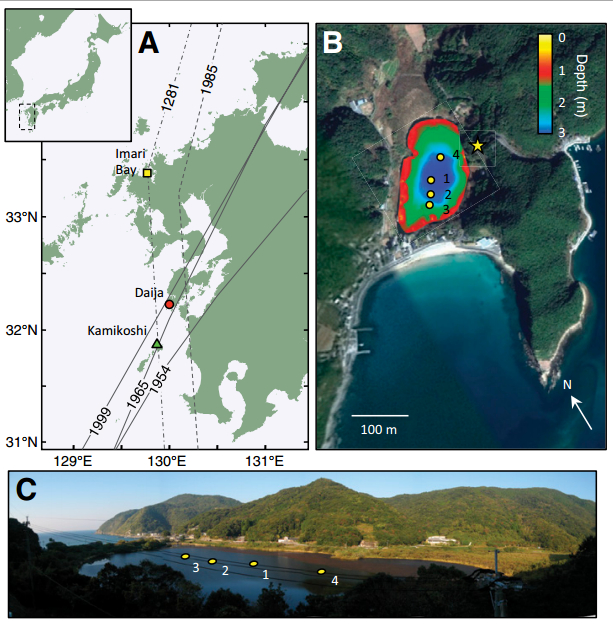The Legend of the Kamikaze Typhoons

Figure 1 from Woodruff et al.
Early narratives describe the decimation and dispersal of these fleets by the “Kamikaze” of CE 1274 and CE 1281 — a pair of intense typhoons divinely sent to protect Japan from invasion.
These historical accounts are prone to exaggeration, and significant questions remain regarding the occurrence and true intensity of these legendary typhoons.
For independent insight, we provide a new 2,000 year sedimentary reconstruction of typhoon overwash from a coastal lake near the location of the Mongol invasions. Two prominent storm deposits date to the timing of the Kamikaze typhoons and support them being of significant intensity.
Our new storm reconstruction also indicates that events of this nature were more frequent in the region during the timing of the Mongol invasions. Results support the paired Kamikaze typhoons in having played an important role in preventing the early conquest of Japan by Mongol fleets.
In doing so, the events may provide one of the earliest historical cases for the shaping of a major geopolitical boundary by an increased probability of extreme weather due to changing atmospheric and oceanic conditions.
FEATURED ARTICLE
Depositional evidence for the Kamikaze typhoons and links to changes in typhoon climatology
J.D. Woodruff et al., Dept. of Geosciences, University of Massachusetts, Amherst, Massachusetts 01003, USA. Published online ahead of print on 4 Dec. 2014; http://dx.doi.org/10.1130/G36209.1.
Contact:
Kea Giles
Managing Editor,
GSA Communications
+1-303-357-1057
kgiles@geosociety.org
Media Contact
More Information:
http://www.geosociety.org/news/pr/2014/14-87.htmAll latest news from the category: Earth Sciences
Earth Sciences (also referred to as Geosciences), which deals with basic issues surrounding our planet, plays a vital role in the area of energy and raw materials supply.
Earth Sciences comprises subjects such as geology, geography, geological informatics, paleontology, mineralogy, petrography, crystallography, geophysics, geodesy, glaciology, cartography, photogrammetry, meteorology and seismology, early-warning systems, earthquake research and polar research.
Newest articles

A universal framework for spatial biology
SpatialData is a freely accessible tool to unify and integrate data from different omics technologies accounting for spatial information, which can provide holistic insights into health and disease. Biological processes…

How complex biological processes arise
A $20 million grant from the U.S. National Science Foundation (NSF) will support the establishment and operation of the National Synthesis Center for Emergence in the Molecular and Cellular Sciences (NCEMS) at…

Airborne single-photon lidar system achieves high-resolution 3D imaging
Compact, low-power system opens doors for photon-efficient drone and satellite-based environmental monitoring and mapping. Researchers have developed a compact and lightweight single-photon airborne lidar system that can acquire high-resolution 3D…





















